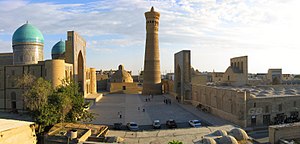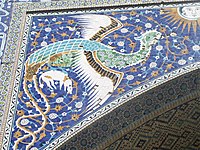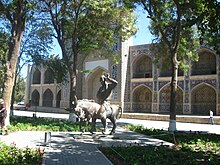Bukhara: Difference between revisions
mNo edit summary |
|||
| Line 77: | Line 77: | ||
==Names== |
==Names== |
||
Bukhara was known as '' |
Bukhara was known as ''Bukhoro'' in 19th- and early 20th-century English publications and as ''Buhe/Puhe''(捕喝) in Tang Chinese.<ref name="umid">{{cite web| url=http://www.umid.uz/Main/Uzbekistan/General_Info/general_info.html| title=General Info| author="UMID" Foundation, Uzbekistan| accessdate=2007-10-04}}</ref> |
||
''[[Encyclopædia Iranica]]'' mentions that the name Bukhara is possibly derived from the [[Soghdiana|Soghdian]] ''βuxārak'' (Place of Good Fortune).<ref>Richard N Frye, [http://www.iranica.com/newsite/articles/v4f5/v4f5a028.html 'Bukhara i. In pre-Islamic times'], ''[[Encyclopædia Iranica]]'', 512.</ref> |
''[[Encyclopædia Iranica]]'' mentions that the name Bukhara is possibly derived from the [[Soghdiana|Soghdian]] ''βuxārak'' (Place of Good Fortune).<ref>Richard N Frye, [http://www.iranica.com/newsite/articles/v4f5/v4f5a028.html 'Bukhara i. In pre-Islamic times'], ''[[Encyclopædia Iranica]]'', 512.</ref> |
||
Revision as of 05:30, 18 March 2014
Bukhara
| |
|---|---|
 | |
| Country | |
| Province | Bukhara Province |
| Founded | 6th Century BC |
| First mention | 500 |
| Government | |
| • Hokim | Rustamov Qiyomiddin Qahhorovich |
| Area | |
| • City | 39.4 km2 (15.2 sq mi) |
| Elevation | 225 m (738 ft) |
| Population (2009) | |
| • City | 263,400 |
| • Density | 6,700/km2 (17,000/sq mi) |
| • Urban | 283,400 |
| • Metro | 328,400 |
| Time zone | GMT +5 |
| Postcode | 2001ХХ |
| Area code | (+998) 65 |
| Vehicle registration | 20 (previous to 2008) 80-84 (2008 and newer) |
| Website | http://www.buxoro.uz/ |
| UNESCO World Heritage Site | |
|---|---|
 | |
| Criteria | Cultural: ii, iv, vi |
| Reference | 602 |
| Inscription | 1993 (17th Session) |
Bukhara ([Buxoro] Error: {{Lang-xx}}: text has italic markup (help); Persian: بخارا; Tajik: Бухоро; Russian: Бухара; from Sanskrit vihara or Soghdian βuxārak, "lucky place") is the capital of the Bukhara Province (viloyat) of Uzbekistan. Bukhara is a city-museum, with about 140 monuments of architecture.[1] The nation's fifth-largest city, it has a population of 263,400 (2009 census estimate). The region around Bukhara has been inhabited for at least five millennia, and the city has existed for half that time. Located on the Silk Road, the city has long been a center of trade, scholarship, culture, and religion. The historic center of Bukhara, which contains numerous mosques and madrassas, has been listed by UNESCO as a World Heritage Site. Persian-speaking Tajiks constitute the largest element of the city's population. The city has long had a mixed population including Jews and other ethnic minorities.
Names
Bukhara was known as Bukhoro in 19th- and early 20th-century English publications and as Buhe/Puhe(捕喝) in Tang Chinese.[2]
Encyclopædia Iranica mentions that the name Bukhara is possibly derived from the Soghdian βuxārak (Place of Good Fortune).[3]
Muhammad ibn Jafar Narshakhi in his History of Bukhara (completed 943-44 CE) mentions:
Bukhara has many names. One of its name was Numijkat. It has also been called "Bumiskat". It has 2 names in Arabic. One is "Madinat al Sufriya" meaning - "the copper city" and another is "Madinat Al Tujjar" meaning - "The city of Merchants". But, the name Bukhara is more known than all the other names. In Khorasan, there is no other city with so many names[4]
History
The history of Bukhara stretches back millennia. It is now the capital of the Bukhara Province (viloyat) of Uzbekistan. Located on the Silk Road, the city has long been a center of trade, scholarship, culture, and religion. During the golden age of the Samanids,[5] Bukhara became the intellectual center of the Islamic world. The historic center of Bukhara, which contains numerous mosques and madrassas, has been listed by UNESCO as one of the World Heritage Sites.
Bukhara has been one of the main centres of World Civilization from its early days in 6th century BCE. From the 6th century CE, Turkic speakers gradually moved in. Its architecture and archaeological sites form one of the pillars of Central Asian history and art. The region of Bukhara was a part of the Persian Empire for a long time. The origin of many of its current inhabitants goes back to the period of Aryan immigration into the region.
Major sights
Fitzroy Maclean, then a young diplomat in the British Embassy in Moscow, made a surreptitious visit to Bokhara in 1938, sight-seeing and sleeping in parks. In his memoir Eastern Approaches, he judged it an "enchanted city", with buildings that rivalled "the finest architecture of the Italian Renaissance".
Po-i-Kalan complex

The title Po-i Kalan (also Poi Kalân, Persian پای کلان meaning the "Grand Foundation"), belongs to the architectural complex located at the base of the great minaret Kalân.
- Kalyan minaret. More properly, Minâra-i Kalân, (Pesian/Tajik for the "Grand Minaret"). It is made in the form of a circular-pillar brick tower, narrowing upwards, of 9 meters (30 feet) diameter at the bottom, 6 meters (20 feet) overhead and 45.6 meters (150 feet) high. Also known as the Tower of Death, as for centuries criminals were executed by being thrown off the top.
- Kalân Mosque (Masjid-i Kalân), arguably completed in 1514, is equal to the Bibi-Khanym Mosque in Samarkand in size. Although they are of the same type of building, they are absolutely different in terms of art of building.
- Mir-i Arab Madrassah. Little is known about its origin, although its construction is ascribed to Sheikh Abdullah Yamani of Yemen, the spiritual mentor of early Shaybanids. He was in charge of donations of Ubaidollah Khan (gov. 1533-1539), devoted to construction of madrasah.
Olot tumani
Ismail Samani mausoleum
The Ismail Samani mausoleum (9th-10th century), one of the most esteemed sights of Central Asian architecture, was built in the 9th century (between 892 and 943) as the resting-place of Ismail Samani - the founder of the Samanid dynasty, the last Persian dynasty to rule in Central Asia, which held the city in the 9th and 10th centuries. Although in the first instance the Samanids were Governors of Khorasan and Ma wara'u'n-nahr under the suzerainty of the Abbasid Caliphate, the dynasty soon established virtual independence from Baghdad.
Chashma-Ayub mausoleum
Chashma-Ayub is located near the Samani mausoleum. Its name in Persian means Job's spring due to the legend according to which Job (Ayub) visited this place and brought forth a spring of water by the blow of his staff on the ground. The water of this well is still pure and is considered healing. The current building was constructed during the reign of Timur and features a Khwarazm-style conical dome uncommon in Bukhara.
Lab-i Hauz

The Lab-i Hauz (or Lab-e hauz, Persian: لب حوض, meaning by the pond) Ensemble (1568–1622) is the name of the area surrounding one of the few remaining hauz (ponds) in the city of Bukhara. Until the Soviet period there were many such ponds, which were the city's principal source of water, but they were notorious for spreading disease and were mostly filled in during the 1920s and 1930s. The Lab-i Hauz survived because it is the centrepiece of a magnificent architectural ensemble, created during the 16th and 17th centuries, which has not been significantly changed since. The Lab-i Hauz ensemble, surrounding the pond on three sides, consists of the Kukeldash Madrasah[6] (1568–1569), the largest in the city (on the north side of the pond), and of two religious edifices built by Nadir Divan-Beghi: a khanaka[7] (1620), or lodging-house for itinerant Sufis, and a madrasah[8] (1622) that stand on the west and east sides of the pond respectively.
There is also an interesting metal sculpture of Nasruddin Hodja, the quick-witted and warm-hearted man, who forms the central character of many children's folk stories in the Central Asian and Indian subcontinent, sitting atop his mule with one hand on his heart and the other with an 'All OK' sign above his head.

Bukhara Fortress, the Ark

mosque of Ali el hamadoni
In bukharo there is a masjid of Mir Sayyid Ali Hamadani[9]
Char Minor
A beautiful building tucked away in one of the lanes behind the Lyabi Hauz complex is the Char Minor. This building is now surrounded mainly by small houses and shops on its perimeter. One may find an artisan or two selling a fine piece of hand drawn paintings.

Transportation
The M37 highway connects the city to most of the major cities in Turkmenistan including Ashgabat.
Demographics
The population of the city consists of Persian-speaking Tajiks[citation needed] who may form the majority, as well as Uzbeks. Until the 20th century, Bukhara was also home to the Bukharan Jews, whose ancestors settled in the city during Roman times. Most Bukharan Jews left Bukhara between 1925 and 2000 and settled in Israel and the United States of America.
Poetry and literature

Being a cultural magnet, Bukhara has long appeared in much local and Persian literature[citation needed]. Many examples can be given.
ای بخارا شاد باش و دیر زی
Oh Bukhara! Be joyous and live long!
شاه زی تو میهمان آید همی
Your King comes to you in ceremony.
---Rudaki
Dehkhoda defines the name Bukhara itself as meaning "full of knowledge", referring to the fact that in antiquity, Bukhara was a scientific and scholarship powerhouse. Rumi verifies this when he praises the city as such:
آن بخارا معدن دانش بود
"Bukhara is a mine of knowledge,
پس بخاراییست هرک آنش بود
Of Bukhara is he who possesses knowledge."
In the Italian romantic epic Orlando innamorato by Matteo Maria Boiardo, Bukhara is called Albracca and described as a major city of Cathay. There, within its walled city and fortress, Angelica and the knights she has befriended make their stand when attacked by Agrican, emperor of Tartary. As described, this siege by Agrican resembles the historic siege by Genghis Khan in 1220.[10]
Notable people


Many notable people lived in Bukhara in the past. Among them are:
- Muhammad Ibn Ismail Ibn Ibrahim Ibn al-Mughirah Ibn Bardizbah al-Bukhari (810-870) - Islamic scholar and compiler of hadiths
- Avicenna (Abu Ali ibn Sina) (980-1037) - physician and person of encyclopedic knowledge
- Bal'ami: Abolfazl Muhammad and his son Abu-Ali Mohammad, two famous viziers of Samanid kings, historians and patrons of art and literature
- Abubakr Narshakhi (10th century) - historian who wrote History of Bukhara
- Sadiduddin Muhammad Aufi (1171-1242) historian, scientist, and author.
- Hazrat Syed Jalaluddin Surkh-Posh Bukhari(c. 595-690 AH, 1199-1291 CE)
- Baha-ud-Din Naqshband Bukhari (1318–1389)
- Amir Kulal (died in 1370)
- Kiromi Bukhoroi
- An Lushan
- Sadriddin Ayni (1878–1954)
- Abdurauf Fitrat
- Oksana Chusovitina
- Sayyid Ajjal Shams al-Din Omar
Sister cities
See also
References
- ^ Города Узбекистана, Таш.. 1965; Ашуров Я. С., Гелах Т. Ф., Камалов У. Х., Бухара, Таш., 1963; Сухарева О. А., Бухара XIX—начала XX вв., М., 1966; Пугаченкова Г. А., Самарканд, Бухара, 2 изд., [М, 1968]; Бухара. Краткий справочник, 4 изд., Таш., 1968.
- ^ "UMID" Foundation, Uzbekistan. "General Info". Retrieved 2007-10-04.
- ^ Richard N Frye, 'Bukhara i. In pre-Islamic times', Encyclopædia Iranica, 512.
- ^ Narshaki,Richard Nelson Fyre, The History of Bukhara, Pg 27
- ^ "Information about Bukhara". Retrieved 2013-05-01.
- ^ Dmitriy Page, Pagetour.narod.ru. "Kukeldash Madrasah". Retrieved 2007-10-04.
- ^ Dmitriy Page, Pagetour.narod.ru. "Nadir Divan-Begi Khanaka". Retrieved 2007-10-04.
- ^ Dmitriy Page, Pagetour.narod.ru. "Nadir Divan-Begi Madrasah". Retrieved 2007-10-04.
- ^ jaffer badakshi in khasatul munakib reference by jeelani allaie
- ^ Boiardo: Orlando innamorato, verse translation by Charles Stanley Ross (Oxford University Press, 1995), Book I, Cantos 10-19 and Explanatory Notes, pp. 401-402. ISBN 0-19-282438-4
Further reading
- Moorcroft, William and Trebeck, George. 1841. Travels in the Himalayan Provinces of Hindustan and the Panjab; in Ladakh and Kashmir, in Peshawar, Kabul, Kunduz, and Bokhara... from 1819 to 1825, Vol. II. Reprint: New Delhi, Sagar Publications, 1971.
External links
- Forbes, Andrew, & Henley, David: Timur's Legacy: The Architecture of Bukhara and Samarkand (CPA Media).


